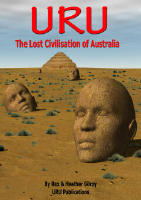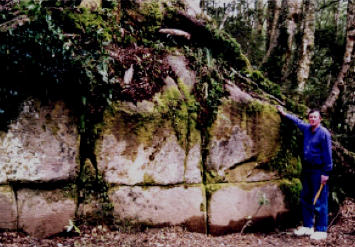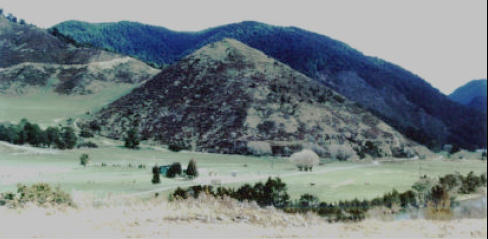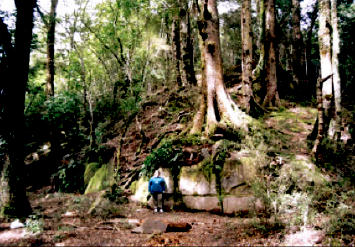Pyramid In the Forest [continued]
Placing their families on the raft, they also took on board Tiu [“fly like a bird without flapping its wings*”] and Ret [snare], and a female named Wai-puna-hau [“source of the wind”] and many other women besides. [*obviously birdmen and women].
As the flood reached one settlement after another the great raft and its occupants floated freely on the surface and then on down the river Tohinga and into a number of streams. Eventually the raft entered the open sea. Lighting a fire by friction they offered sacrifices to the gods in thanks for their being saved.
They sailed on for eight months [or moons] until they sighted land appearing above the waters. This was Hawaiki, and they landed there.
These “Great Flood” traditions, handed down by the Uru to later arrivals on these shores, including the Morioris, are similar to others passed on by the Uru to other near-neighbours they came into contact with, including the native peoples of New Guinea and island Melanesia.
There can be no doubt that the Uru ruled Wainga-roa and New Zealand for thousands of years, as their ocean-going watercraft were exploring the ancient world. New Zealand had been part of this great Pacific extension of the Australian Uruan civilisation, which some time around 15,000 years ago, had begun spreading eastwards. Their vessels would have crossed the narrow sea created by the Wainga-roa land-shelf, from the Australian East Coast, to establish the megalithic cities and ceremonial sites.
In later times with the great submergence having formed the present-day islands, the Uru continued their spread across the Pacific, eventually to reach the shores of Central and South America.
Population increases were largely responsible for the Uru colonising expeditions, in the course of which, their large New Zealand population was reduced. Even so, there appears to have been a considerable population of Uru in North and South Island by the time of the first Polynesian arrivals.
In their migrations from Australia the Uru carried their written language with them, particularly to the west Pacific islands including New Zealand.
Then YHWH answered and said,
“Write the vision down, inscribe it on
tablets to be easily read.”
Habakkuk 2:2.
Rocks bearing the script of the Uru occur from southeastern to mainland Asia and throughout the rest of the Old World, and across the Pacific to the Americas. They are also found in profusion at widely scattered sites throughout New Zealand. During our 1997 New Zealand field investigation, Heather and I uncovered Uruan rock inscriptions in the vicinity of a number of altar stones near Mt Maunganui outside Tauranga in North Island’s Bay of Plenty, reputed to have been a massive hill fort of the Patupaiarehe, also known as the Turehu, or “Lords of the Soil”, a red or fair-haired, blue-eyed, white-skinned race which Maori tradition admits, preceded them to these shores.
It was this race which introduced the arts of agriculture to these islands, and erected massive megalithic structures throughout the country. The remains of their agricultural activities are still to be seen today wherever they erected their characteristic stepped [pyramid] or rounded [ziggurat] hill forts [later utilised and copied by the Maoris], in the form of irrigation ditches and terracing. They also utilised natural hills, shaping them into four and sometimes three-sided pyramids, as in the case of one 90m tall, flat-topped, four-sided pyramid-hill found in Central South Island.
Ancient agricultural terracing
for the growing of taro, covers much
of the south face of Mt Maunganui,
nearby which in 1997 an Uruan rock
inscription was found naming it “Mountain of the Sun”. The form of
script here is “Late Advanced Uruan”,
which places the site around 7,000
years BP. The Uruan Sun-Worship
religion is well represented here among
the many altars. One elaborate altar
measures 93cm tall by 1.2m wide, by
1.92m long with two carved steps
leading up to a flat, 1.26m square
summit. Nearby, during our 1997 visit,
an Uruan stone inscription was found,
afterwards translated to read “Land of
Lawana”. A second such inscription
found in the same area during our
1998 return visit to the site re-inforced
my belief that this was the name of an
Uruan monarch of old New Zealand..
Another inscription found upon a nearby stone slab in 1997 translates as ‘Nim’, the name of their Sun-God
found across Australia. During our 1997 return visit to
the site, we turned up two more Uruan
rock inscriptions. One states “Rain
brings winter”, the other reads “Mountain of the Sun”, suggesting Mt
Maunganui was a ceremonial Sunworship
site.
I have already mentioned in
Chapter Eleven my discovery of a little ‘Birdman’ image at Mt Maunganui
The image of the birdman in
various forms is found from
Mesopotamia to New Guinea and
Australia; Central Pacific islands,
Easter Island and the Americas. Yet
his oldest representations appear only
in Australia, implying that the birdman
and associated cults were spread
beyond Australia by world-travelling
Uruans at the dawn of history.
The Uru/Patupaiarehe brought
their agricultural skills to New
Zealand. They developed extensive
taro gardens, and also constructed
large stone fishtraps in bays and inlets
around the country. Extensive
networks of often enormous stepped
pyramid-shaped Pa’s outside Auckland
and in the Tauranga district, as well as
around the foreshores of Lake
Rotorua, suggest the Uruan
populations must have numbered in
thousands at one time, and
overpopulation would have been a
principal incentive for colonising
voyages to be dispatched further out
into the Pacific Ocean.
The Central North Island
plateau was a major culture centre of
the Uru/Patupaiarehe. Massive
Rhyolite stone blocks were cut from a
mountainside quarry, and dragged a
dozen kilometres and more for the
construction of huge stepped pyramid
temples and other stone monuments,
which now lie barely exposed amid a
15m or more deep layer of volcanic
ash, in what is now the Kaimanawa
State Forest outside Lake Taupo.

 Stone Head Of
King Tamo
Stone Head Of
King Tamo


 altar Stone
altar Stone  New Zealand Countryside
New Zealand Countryside  Basalt Wall
Basalt Wall 

